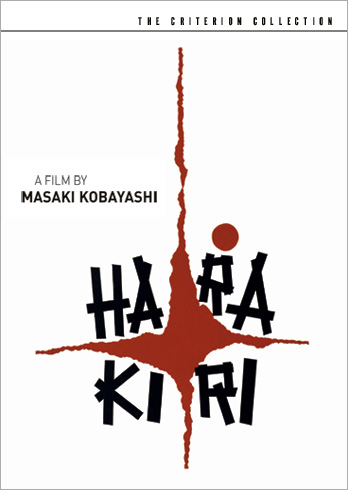Home Video Hovel: Harakiri
You have to see this film. I have no idea why that message hasn’t been adequately communicated, but I’m certain nobody told me. But you really, honestly, must see this film.
Hanshiro Tsugumo, an unemployed samurai with nothing to lose, arrives at the House of Iyi, asking permission to commit ritual suicide on their property. We can see it in his eyes, which rarely blink; his calm, unwavering voice convinces us he has no intention of leaving alive. But as they say, a man with nothing to lose is the most dangerous of all.
From this simple premise, screenwriter Shinobu Hashimoto and director Masaki Kobayashi spin a story that seems to encompass everything, though very little actually happens. Most of the story is told in flashbacks, technically, showing how Tsugumo (Tatsuya Nakadai) came to arrive at the House of Iyi, and why he knows so much about its retainers. Flashbacks are usually cinematic poison, but as Hasimoto says in one of the supplements, “it isn’t a flashback if it moves in the direction of the drama.” The structure of the film alone is overwhelmingly brilliant; Hashimoto drops little hints here and there, knowing exactly when to reveal a key piece of information and how to foreshadow others, while keeping us in complete suspense about something we already know on a gut level.
This is to say nothing of Kobayashi’s direction, keeping us on the edge of our seats during even the most banal conversation, enrapturing us with an image as simple as a man walking down a hallway. You can imagine what happens, then, when violence erupts. Kobayashi frames his actors’ physicality in an angular, expressive, inherently violent way – watching the men prepare to fight is almost more exciting than the fight itself. He creates terrific visual parallels, such as showing happier times with flower petals floating in the breeze, and difficult times with an oppressive snowfall. The film grabs you from frame one and absolutely does not let go, never taking the easy way out, always holding itself accountable for the stakes it’s introduced. It’s a surprisingly flooring emotional experience, and at two hours and fifteen minutes, contains not a wasted frame nor a boring scene. If I were to be so bold to call a film “perfect” after only a single viewing, Harakiri would be such a film.
There is so much more I want to say about the film (including Nakadai’s amazing performance), but I would hate to spoil any of it. If you have not yet seen it, The Criterion Collection’s new Blu-Ray is the perfect opportunity. The transfer looks absolutely gorgeous, presenting cinematographer Yoshio Miyajima’s deep-focus work crisp and clear, with just enough grain to allow for the proper depth. There are a few digital artifacts, and some damage marks remain early on, but on the whole I was very pleased. I haven’t checked out Criterion’s DVD edition, but many of the supplements on this disc were made for that version, and the transfer they present in those bears similar quality to other stuff they were putting out at that time. If they are a fair comparison, the upgrade is significant. According to the packaging, it is presented in its original aspect ratio of 2.35:1, though DVD Beaver notes some very minor cropping on the sides, and puts it closer to 2.31:1. I don’t feel this impacts the film, but it’s worth putting out there.
The audio is similarly strong, and this is a good point to talk about the score. If Kobayashi’s visuals don’t do the trick, Toru Takemitsu’s just-this-side-of-dissonant score will absolutely do the trick. A lot has been written in the last few years about how electronic music has revitalized cinematic soundtracks, but one need only to spend some time with European and Japanese films of the 1960s to see (or hear) there’s nothing new under the sun. It’s a different process, to be sure, but the results are very similar. Takemitsu isn’t afraid to go big while doing relatively little, and the impact is indispensable.
The supplements are sparse, but mostly solid. Donald Richie’s “introduction” should absolutely, under no circumstances, be watched before viewing the film, but it’s a nice overview of the themes, aesthetic accomplishments, and emotional impact of the film. It runs just under twelve minutes.
We also get an excerpt from an interview with Kobayashi, moderated by filmmaker Masahiro Shinoda, which is…sadly almost worthless. Shinoda talks at length about how wonderful Harakiri is with the enthusiasm of a fanboy, rarely asking an actual question, leaving Kobayashi with little more to say than “yeah, how about that?” or “the funny thing about that is…”. I ordinarily relish an opportunity to hear master directors talk about any aspect of their craft, no matter how minor, but there’s really nothing here.
Much better are video interviews with Nakadai and Hashimoto, both of whom are still alive, though these were recorded in 2005. Nakadai talks about how the 1950s and 60s were a “golden age” of Japanese cinema, which he believes declined sharply following Harakiri. It’s not a perfect point of reference (he was in High and Low the following year), but looking at his filmography – which, prior to Harakiri, includes The Human Condition, When a Woman Ascends the Stairs, Yojimbo, and Sanjuro – it’s also not hard to see where he’s come from. He also talks about his process preparing for the character, who was twenty years older than he was at the time they filmed it. Actors don’t always make for the most interesting interviews, but his is great.
Hashimoto is also a man of good humor, noting how one night, watching the film with his daughter, she turned to him and said “wow, you used to be really smart, dad!” He shares some memories of working with Kobayashi and Kurosawa (with whom he was a frequent collaborator, writing such films as Seven Samurai, Rashomon, Ikiru, and The Bad Sleep Well), talks about the flashback structure, and dismisses readings of the film as anti-authoritarian. I’d disagree with him on that last point, but he says that, at the very least, if that theme does exist, he wasn’t conscious of it during the writing process, which allowed him to focus more on the emotional center. So it’s hard to totally fault the guy.
And, of course, we get a 32-page booklet, this one containing an essay by Joan Mellen and a reprint of her interview with Kobayashi in 1972. Both are primarily concerned with Kobayashi’s socio-political ideas and how he expresses them in his work, but the latter also gets into some fundamentals of directing. His method boils down to thinking very intensely about the film leading up to production, and then putting all of that out of his head so that he can make the film purely from his gut instincts. Harakiri certainly bears that mark.
I do not often tell people to drop everything and go see something, mostly because I could easily fall into a never-ending spiral, but you really, really have to see Harakiri. It’s one of those rare films in which every single element fell perfectly into place, but none of it feels overly calculated; it’s all fresh and urgent and absolutely gutting. Criterion gives us a wonderful transfer, and while the supplements could be better, it earns my highest recommendation on the quality of the film alone. It’s absolutely essential viewing, so rent it at the very least, but if you have $28 to throw around, you could do much, much worse (see: nearly every other film). If you already own the DVD, it looks like the Blu-Ray provides a significant upgrade with a much more film-like texture, but if you don’t…man, buy the hell out of this one.





























Well, you’ve convinced me.
As Charlie Sheen says, this aitrlce is “WINNING!”
Awesome! Be sure to swing back by here and let me know what you thought.
A great review of an equally great chambara movie. Harakiri was the movie that, in my personal opinion, presented the dark side of Samurai way of life for the first time on the celluloid. The movie’s finale sequence is blood-cuddling and it’s sheer power can make a cold-blooded appear jittery. In fact the same can be said about the movie as a whole. You review has helped me get a deeper insight into Harakiri. I look forward to reading more of your reviews.
Also, please do check out my review of Masaki Kobayashi’s Harakiri.
http://www.apotpourriofvestiges.com/2012/06/harakiri-1962-japanese-auteur-masaki.html